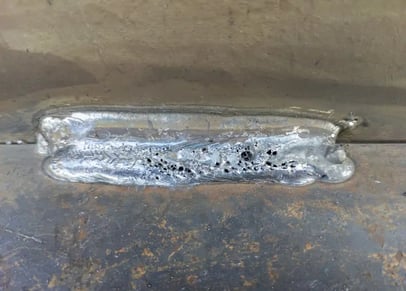What is Porosity in Welding: Recognizing Its Causes and Enhancing Your Skills
What is Porosity in Welding: Recognizing Its Causes and Enhancing Your Skills
Blog Article
Porosity in Welding: Identifying Common Issues and Implementing Ideal Practices for Avoidance
Porosity in welding is a pervasive problem that often goes undetected until it creates significant issues with the integrity of welds. In this discussion, we will discover the key aspects contributing to porosity formation, analyze its detrimental effects on weld efficiency, and discuss the finest practices that can be adopted to reduce porosity occurrence in welding procedures.
Common Reasons of Porosity

Another frequent offender behind porosity is the presence of contaminants externally of the base steel, such as oil, oil, or corrosion. When these contaminants are not effectively removed before welding, they can vaporize and become entraped in the weld, creating issues. Using unclean or wet filler materials can introduce contaminations right into the weld, adding to porosity concerns. To alleviate these typical root causes of porosity, complete cleansing of base metals, proper securing gas option, and adherence to ideal welding parameters are important practices in attaining high-quality, porosity-free welds.
Influence of Porosity on Weld High Quality

The presence of porosity in welding can dramatically jeopardize the architectural integrity and mechanical homes of welded joints. Porosity produces voids within the weld steel, weakening its general toughness and load-bearing capability. These gaps serve as stress and anxiety concentration points, making the weld extra vulnerable to fracturing and failure under used loads. Furthermore, porosity can lower the weld's resistance to corrosion and various other ecological elements, additionally diminishing its durability and efficiency.
Welds with high porosity degrees often tend to show lower effect strength and reduced ability to deform plastically before fracturing. Porosity can restrain the weld's capacity to successfully transfer forces, leading to premature weld failing and prospective security hazards in critical frameworks.
Finest Practices for Porosity Prevention
To boost the architectural honesty and top quality of welded joints, what specific actions can be applied to lessen the event of porosity during the welding process? Porosity avoidance in welding is important to ensure click for more info the honesty and stamina of the final weld. One effective technique is appropriate cleansing of the base steel, removing any kind of pollutants such as rust, oil, paint, or dampness that could bring about gas entrapment. Ensuring that the welding tools is in excellent condition, with tidy consumables and proper gas flow rates, can additionally substantially decrease porosity. In addition, preserving a secure arc and controlling the welding specifications, such as voltage, present, and travel speed, aids produce a regular weld pool that lessens the risk of gas entrapment. Utilizing the correct welding method for the details material being welded, such as readjusting the welding angle and weapon placement, can even more protect against porosity. Regular examination of welds and immediate remediation of any kind of issues determined throughout the welding procedure are important methods to prevent porosity and produce top notch welds.
Importance of Proper Welding Techniques
Implementing proper welding techniques is extremely important in guaranteeing the structural stability and high quality of welded joints, developing upon the foundation of efficient porosity prevention measures. Welding techniques straight influence the total toughness and longevity of the bonded framework. One essential aspect of proper welding strategies is keeping the right warm input. Excessive warmth can bring about boosted porosity as a result of the entrapment of gases in the weld pool. Conversely, not enough warmth may result in insufficient combination, creating potential weak factors in the joint. Furthermore, using the ideal welding specifications, such as voltage, current, and travel speed, is critical for achieving sound welds with marginal porosity.
Moreover, the choice of welding procedure, whether it be MIG, TIG, or stick welding, should line up with the details demands of the job to ensure ideal outcomes. Proper cleaning and prep work of the base steel, in addition to picking the right filler material, are likewise essential elements of skillful welding strategies. By sticking to these ideal methods, welders can lessen the threat of porosity formation and create high-grade, structurally sound welds.

Testing and Quality Assurance Measures
Evaluating procedures are important to discover and stop porosity in welding, making certain the toughness and longevity of the last item. Non-destructive screening techniques such as ultrasonic testing, radiographic testing, and visual inspection over at this website are commonly used to identify prospective problems like porosity.
Performing pre-weld and post-weld examinations is likewise crucial in maintaining top quality control requirements. Pre-weld inspections entail confirming the materials, equipment settings, and tidiness of the workplace to avoid contamination. Post-weld inspections, on the various other hand, evaluate the last weld for any type of defects, consisting of porosity, and confirm that it fulfills specified criteria. Executing a thorough quality assurance strategy that includes thorough screening treatments and assessments is paramount to about his minimizing porosity issues and making sure the overall high quality of bonded joints.
Final Thought
To conclude, porosity in welding can be a common issue that affects the high quality of welds. By recognizing the usual sources of porosity and executing finest methods for avoidance, such as correct welding strategies and testing measures, welders can guarantee top quality and trusted welds. It is vital to prioritize prevention methods to reduce the incident of porosity and preserve the stability of welded structures.
Report this page